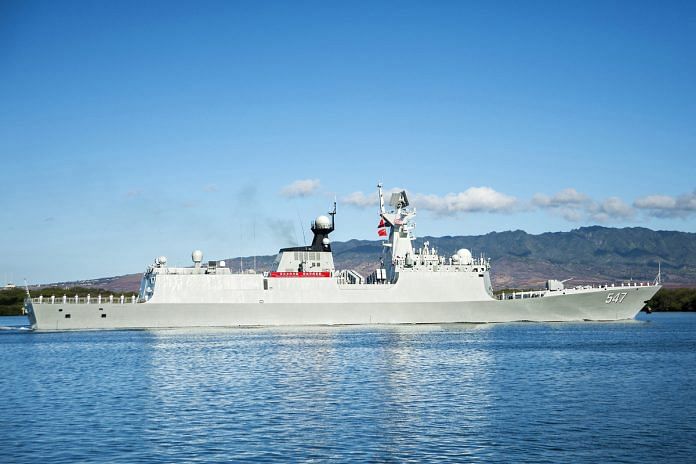Chinese navy produces designs which surpass the most modern ships of the US navy in size, volume, armament and quantity.
The Chinese navy (the People’s Liberation Army Navy or PLAN) has, over the past two decades, augmented its fleet with new capabilities and platforms to control the near seas and fulfil the country’s Blue Navy Dream. By 2050, China is likely to have the largest navy in the world, unless the US navy overcomes its resource crunch. The quality of ships, their armaments and performance is comparable with most modern countries.
Chinese shipbuilding speed has impressed everyone across the board.
A article published by ThePrint on construction of Chinese intelligence ships (Type 815A) evoked a big response. Many comments on social media expressed awe at the speed of construction which has been enormously high. Readers asked how China’s naval shipyards are able to produce such large ships in a short period of time. Some people compared the speed of production to making dumplings.
The PLAN first produced smaller high-speed missile carrying catamarans called Type 22 Houbei class. Around 83 were built in just over eight years. Then the Type 52C and Type 54A, surprised the whole world with speed of construction at Shanghai’s Jiangnan Changxing and Hudong Zhonghua shipyards.
And now the most modern — Type 56, Type 52D, Type 55, Type 815A AGI (Auxiliary General Intelligence), Type 71 LPD (Landing Platform Dock) and even the AOR(Auxiliary Oil Replenishment) Type 901 — are also being built at Shanghai, Wuhan, Guangzhou and Dalian.
No holidays
China’s shipyards do not have the word “holiday’ in their dictionary. There are no Sundays or special festival days observed in any of the shipyards. There are no death anniversaries of politicians, leaders or martyrs observed as holidays.
All shipyards work on three shifts of eight hours in a day. The workforce is regularly circulated. There are no unions calling for shut downs.
Designs of ships
The design bureaus work in similar fashion. The difference is that, they produce designs which surpass the most modern ships of the US navy in size, volume, armament, quantity and quality (which China is yet to prove in an actual combat).
Students in universities are being encouraged to build new designs and innovate on already existing designs.
Most Western experts feel that Chinese ships are crudely constructed and may not withstand the test of combat against a peer navy. They also feel the Chinese submarines are very noisy and would easily be detected when on long duration patrols. The focus of the designers appears to be to produce largest ships in the world.
Construction in modules
The construction of most of the large ships is done in modules, produced either at the same shipyard or at different shipyards, and brought for assembly. These modules are joined together to form the basic structure of the ship, which is later fitted out, thereby saving enormous amount of time.

Different ships in a single shipyard
The monopoly of shipyards in producing a particular type of ship has been broken. Now, different ship types or classes are assembled and built in most of the shipyards.
The Type 52D and Type 55 are being built at Jiangnan Changxing, popularly known as JNCX, along with the Yuanwang and MCMVs. In December 2016, there were at least 16 different ships being constructed at Jiangnan Changxing at a particular time.

Similarly, Dalian shipyard is constructing three Type 52D, two Type 55 and also the CV-17 at the same time.
Recent trends indicate that larger shipyards like Hudong Zhonghua, Jiangnan Changxing and Dalian are constructing two ships of a class at any given time. In the case of Type 55, at both Dalian and Jiangnan Changxing they are being built simultaneously so that even the launch date would coincide.

It is also rumoured that the new facility for construction of CV (carrier vessel) will be able to construct two CVs at a time.
Submarines
The newly built facilities for construction of submarines at Huludao and Jiangnan Changxing are very large. The sizes of 290m X 135m are indicative that at any given time a minimum of four submarines will be under construction at these two yards.

Implications
China is likely to produce ships at this fast pace for another 30 years. India needs to learn a thing or two from its adversary to improve its shipyards. Permitting private sector to participate in shipbuilding alone will not suffice. The public sector too has to be a willing and strong partner.
Col Vinayak Bhat (retd) is a Military Intelligence veteran of the Indian Army with vast experience of satellite imagery analysis.
He has worked as Chinese interpreter and is a specialist on PLA and Pakistan’s Armed Forces. He tweets @rajfortyseven







Excellent and interesting info provided by Col Bhatt.
Thanks
We Indians want innumerable vacations and comforts. How can we achieve even 1/4th of this capability of China???
Agreed. We are too slow and sentimental, we sing too much and dance to long- cover the mountain, sea, lake and sky. OMG…Kuch Kuch Ko Ta Hai
With our Public Sector Shipyards,IAS and Navy there is no chance of building at this rate . The Navy Brass really has no perspective ,just mouths received wisdom , the IAS is UGC pass permanant genius and our manufacturing well ,look at Mazgon and Cochin . Holidays don’t matter as much as modern, innovative, offsite-onsite manufacturing , Korea and Japan pioneered these techniques . Robots, etc but more importantly will and desire . Do we really want to be #1 and counter China ? Private sector is into being cronies . Can they even make a paper boat ?